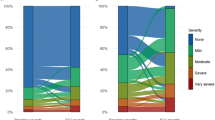Abstract
Purpose
Prediction of the postoperative course of esophagectomy is an important part of the strict perioperative management of patients undergoing surgery for esophageal cancer.
Methods
To evaluate their clinical importance, peripheral blood values, including white blood cell count (WBC), lymphocyte count, and the levels of total protein, transferrin, factor XIII, D-dimer, fibrin, and fibrinogen degradation products (FDP) were measured before and after esophagectomy for esophageal cancer in 24 patients.
Results
The preoperative WBC and the pre- and postoperative lymphocyte count were decreased remarkably in patients who received preoperative chemoradiotherapy. The values of perioperative serum transferrin were significantly lower in patients with postoperative pneumonia than in those without. The activity of plasma factor XIII was suppressed on postoperative day (POD) 7 in patients with pneumonia and on POD 14 in patients with leakage.
Conclusions
These results suggest that patients who receive preoperative chemoradiotherapy are potentially immunosuppressed, the preoperative serum transferrin level is a possible predictive marker of postoperative pneumonia, and suppression of factor XIII activity is related to anastomotic insufficiency.
Similar content being viewed by others
References
Wu PC, Posner M. The role of surgery in the management of oesophageal cancer. Lancet Oncol 2003;4:481–488.
Jamieson GG, Mathew G, Ludemann R, Wayman J, Myers JC, Devitt PG. Postoperative mortality following oesophagectomy and problem in reporting its rate. Br J Surg 2004;9:943–947.
Morita M, Yoshida R, Ikeda K Egashira A, Oki E, Sadanaga N, et al. Advances in esophageal cancer surgery in Japan: an analysis of 1000 consecutive patients treated at a single institute. Surgery 2008;143:499–508.
Shichinohe T, Hirano S, Kondo S. Video-assisted esophagectomy for esophageal cancer. Surg Today 2008;38:206–213.
Li SH, Wang Z, Liu XY, Liu FY, Sun ZY, Xue H. Lymph node micrometastasis: a predictor of early tumor relapse after complete resection of histologically node-negative esophageal cancer. Surg Today 2007;37:1047–1052.
Law S Y, Fok M, Wong J. Risk analysis in resection of squamous cell carcinoma of the esophagus. World J Surg 1994;18:339–346.
Ferguson MK, Martin TR, Reeder LB, Liu FY, Sun ZY, Xue H. Mortality after esophagectomy: risk factor analysis. World J Surg 1997;21:599–603.
Whooley BP, Law S, Murthy SC, Alexandrou A, Wong J. Analysis of reduced death and complication rates after esophageal resection. Ann Surg 2001;233:338–344.
Fagevik Olsen M, Wennberg E, Josefson K, Lönroth H, Lundell L. Randomized clinical study of the prevention of pulmonary complications after thoracoabdominal resection by two different breathing techniques. Br J Surg 2002;89:1228–1234.
Fan ST, Lau WY, Yip WC, Poon GP, Yeung C, Lam WK, et al. Prediction of postoperative pulmonary complications in oesophagogastric cancer surgery. Br J Surg 1987;74:408–410.
Law SY, Fok M, Wong J. Risk analysis in resection of squamous cell carcinoma of the esophagus. World J Surg 1994;18:339–346.
Lund O, Kimose HH, Aagaard MT, Hasenkam JM, Erlandsen M. Risk stratification and long-term results after surgical treatment of carcinomas of the thoracic esophagus and cardia. A 25-year retrospective study. J Thorac Cardiovasc Surg 1990;99:200–209.
Bartels H, Stein HJ, Siewert JR. Preoperative risk analysis and postoperative mortality of oesophagectomy for resectable oesophageal cancer. Br J Surg 1998;85:840–844.
Bosset JF, Gignoux M, Triboulet JP, Tiret E, Mantion G, Elias D, et al. Chemoradiotherapy followed by surgery compared with surgery alone in squamous-cell cancer of the esophagus. N Engl J Med 1997;227:161–167.
Avendano CE, Flume PA, Silvesri GA, King LB, Reed CE. Pulmonary complications after esophagectomy. Ann Thorac Surg 2002;73:922–926.
Fink U, Stein HJ, Wilke H. Multimodal treatment for squamous cell esophageal cancer. World J Surg 1995;19:198–204.
Law S, Wong K, Kwak K, Chu KM, Wong J. Predictive factors for postoperative pulmonary complications and mortality after esophagectomy for cancer. Ann Surg 2004;240:791–800.
Kelley ST, Coppola D, Karl RC. Neoadjuvant chemoradiotherapy is not associated with a higher complication rate vs surgery alone in patients undergoing esophagectomy. J Gastrointest Surg 2004;8:227–232.
Lin FC, Durkin AE, Ferguson MK. Induction therapy does not increase surgical morbidity after esophagectomy for cancer. Ann Thorac Surg 2004;78:1783–1789.
Tsutsui S, Morita M, Kuwano H, Matsuda H, Mori M, Okamura S, et al. Influence of preoperative treatment and surgical operation on immune function of patients with esophageal carcinoma. J Surg Oncol 1992;49:176–181.
Morita M, Yoshida R, Ikeda K, Egashira A, Oki E, Sadanaga N, et al. Acute lung injury following an esophagectomy for esophageal cancer, with special reference to the clinical factors and cytokine levels of peripheral blood and pleural drainage fluid. Dis Esophagus 2008;21:30–36.
Akamoto S, Okano K, Sano T, Yachida S, Izuishi K, Usuki H, et al. Neutrophil elastase inhibitor (Sivelestat) preserves antitumor immunity and reduces the inflammatory mediators associated with major surgery. Surg Today 2007;37:359–365.
Xu J, Zhong Y, Jing D, Wu Z. Preoperative enteral immunonutrition improves postoperative outcome in patients with gastrointestinal cancer. World J Surg 2006;30:1284–1289.
Laki K, Lóránd L. On the solubility of fibrin clots. Science 1948;108:280.
Canonico S. The use of human fibrin glue in the surgical operations. Acta Biomed 2003;74:21–25.
Azim K, McManus R, Brophy K, Ryan A, Kelleher D, Reynolds JV. Genetic polymorphisms and the risk of infection following esophagectomy. positive association with TNF-alpha gene −308 genotype. Ann Surg 2007;246:122–128.
Author information
Authors and Affiliations
Rights and permissions
About this article
Cite this article
Saeki, H., Masuda, T., Okada, S. et al. Impact of perioperative peripheral blood values on postoperative complications after esophageal surgery. Surg Today 40, 626–631 (2010). https://doi.org/10.1007/s00595-009-4135-1
Received:
Accepted:
Published:
Issue Date:
DOI: https://doi.org/10.1007/s00595-009-4135-1




